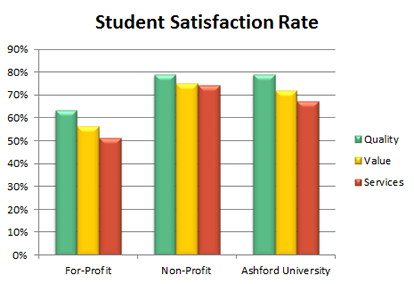Back in July, Ashford University, an education holding of Bridgepoint Education Inc., was denied accreditation from the Western Association of Schools and Colleges (WASC). According to the Associated Press, WASC said that Ashford University “hadn’t shown substantial compliance with its accreditation standards related to student retention and graduation, the alignment of resources with educational objectives and the implementation of a core of full-time faculty that can oversee the university academic policies and ensure the integrity of its programs.”
The statistics in question are Ashford’s 36% retention rate and 37% graduation rate. Those rates are still better than the national average graduation rate of all for profit colleges, which is 28%. Ashford may not be the worst offender, but WASC’s message is loud and clear. In short, Ashford has allocated too much of its budget to recruiting students as opposed to resources that would actually help their students graduate.
Last week, Bridgepoint made a bold move to show it’s taking WASC’s criticisms into serious consideration. In a major shift, Ashford University cut 450 positions that focused solely on admissions and reassigned 400 more. Two hundred admissions employees were reassigned to student services and two hundred more were reassigned to a new department entirely. The new department is supposed to focus on student inquiry.
The change indicates a shift away from heavily criticized recruitment practices. Stock prices have fallen dramatically since the July accreditation announcement and Bridgepoint wants to assure investors and accreditation associations that their focus will be on their current students and not just potential future students yet to be recruited.
In fact, in reviews of Ashford University on Guide to Online Schools, Student Services seems to be the biggest complaint. According to a recent Student Satisfaction Assessment conducted by SR Education Group, 67.5% of Ashford University students were satisfied with the school’s student services. This percentage falls short of Ashford students’ average quality and value satisfaction rates (78.9% and 71.9% respectively).

Across the board, student services fall short. At Ashford, for-profit institutions, and non-profit institutions, student services is the lowest rated category for every type of school reviewed. This indicates that Student Services is an industry-wide weakness that Ashford currently recognizes.
It’s clear that more for-profit institutions need follow in Ashford’s footsteps and look into improving student services. Ashford recognized a weakness and a need and is on the right track to improving itself for the betterment of its students. In the increasing competitive market of for-profit education, the emphasis needs to be placed on setting current students up for success as opposed to garnering as many new students as possible. The institutions that care for their enrolled students will see greater benefits from their improved satisfaction reports and proud alumni. All for-profit institutions should take a leaf out of Zappo’s book and start being powered by service.
